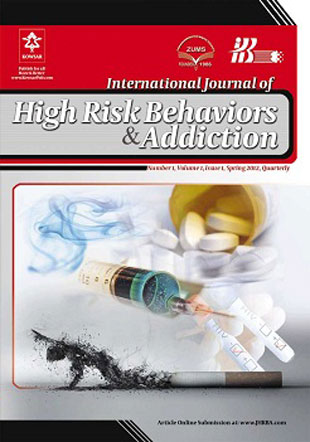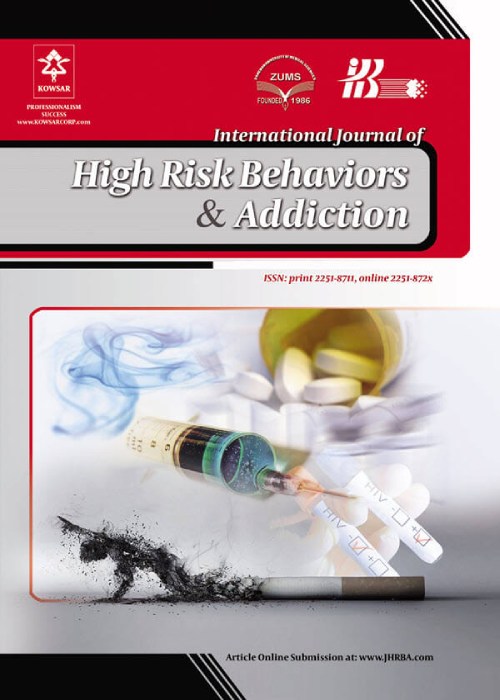فهرست مطالب

International Journal of High Risk Behaviors and Addiction
Volume:3 Issue: 1, Mar 2014
- تاریخ انتشار: 1392/12/24
- تعداد عناوین: 11
-
-
Page 8725BackgroundPrevalence of Type 2 diabetes is increasing rapidly worldwide. Recent data is reprehensive of increasing diabetes prevalence from 285 millions in 2010 (6.4%) to 439 millions in 2030 in adults aged 20 to 79 in different countries. Lifestyle and particularly dietary habits play an important role in the development of diabetes. Additionally, specific individual food groups and diet components such as monounsaturated fatty acids, fruits, vegetables, whole grain cereals, dietary fiber, fish, magnesium and nuts may protect against the development of diabetes, possibly through the amelioration of insulin sensitivity and its anti-inflammatory actions, while consumption of red and processed meats and saturated fat may increase the risk of type 2 diabetes..ObjectivesIn this section, we studied dietary and other factors related to the effect of lifestyle in type 2 diabetes. These factors may affect the incidence of type 2 diabetes which could be corrected by lifestyle modifications..ResultsUnfortunately, dietary habits in the developed and developing countries are changing towards an unhealthier direction. Consequently, emphasis should be given on encouraging at population and individual levels for adopting a healthier lifestyle, including dietary habits, to prevent the development of type 2 diabetes. Here we reviewed epidemiologic and clinical trial evidence regarding nutrients, foods and dietary patterns to diabetes risk and involved possible mechanisms..ConclusionsType 2 diabetes is increasingly growing in young population of developing countries, which causes a large burden on individuals and the society..Keywords: Food Handling, Diabetes Mellitus, Type 2, Life Style, Epidemiologic Studies, Clinical Trial
-
Page 9355BackgroundAddiction for narcotics is a dangerous reality, especially in teenagers and young persons, and is one of the most important socioeconomic and health problems, threatens the human society and leads to social stagnancy in various aspects..ObjectivesThe present study aimed at determining Meta-cognitive relationship with addiction potential tendency in students and determining the distribution of each Meta-cognitive dimension in predicting addiction potential tendency..Materials And MethodsThe descriptive-correlative method was used for conducting this research. The research target population included all students of Ardebil Mohaghegh University. A sample of 380 subjects was selected randomly from this demographic population by cluster multistage sampling. We used Weed and colleagues’ questionnaire of addiction to assess addiction potential tendency, and the Meta-cognitive scale of Wells and colleagues for evaluating Meta-cognition. Data gathered were analyzed by multifold Regression via simultaneous entrance method..ResultsThe rate of students’ addiction potential tendency can be predicted by having characteristics of their Meta-cognition. It also appeared that among the five parameters of Meta-cognition, the role of three parameters required for controlling thoughts, uncontrollability and risk, and positive beliefs about anxiety were of great importance in predicting addiction potential tendency in students..ConclusionsThe results of this research have important implications regarding the attention of students’ counselors to Meta-cognitive dimensions in order to prevent students’ tendency for addiction..Keywords: Behavior, Addictive, Students, Cognition
-
Page 11520BackgroundCrimean-Congo hemorrhagic fever (CCHF), an acute viral infection, is a zoonotic disease which is transmitted to humans by infected ticks, direct contact with fresh meat or blood of infected animals (usually domestic livestock), or direct contact with the blood or secretions of an infected person. Livestock handlers, skin processors, veterinary staff, livestock market workers, and other personnel engaged in jobs requiring some contact with animals and/or animal products are at high risk for CCHF. Most reported cases of this disease in Iran belong to butchers and slaughterhouse workers..ObjectivesWe aimed to study the prevalence of CCHF in slaughterhouse workers and livestock handlers who were admitted to Boo-ali Hospital for treatment of CCHF..Materials And MethodsWe evaluated all patients’ files with confirmed CCHF admitted to Boo-ali Hospital in Zahedan, in southeastern part of Iran, during 1999-2011. Then, we examined the prevalence of disease among the high risk groups..ResultsOut of 362 patients with CCHF (86% male, 14% female; with age range 12-78 years), 123 (34%) were slaughterhouse workers, 103 (28.5%) livestock handlers and farmers, 32 (9%) housewives, 7 (2%) students, 6 (1.9%) teachers, 4 (1.2%) military personnel, and other groups were workers with different employments..ConclusionsThe present study showed that CCHF is highly prevalent in high risk occupational groups in Zahedan, Iran. Further surveillance, teaching and prevention programs are recommended..Keywords: Hemorrhagic Fever, Crimean, Prevalence, Dangerous Behavior
-
Page 12120BackgroundOral cancer is one of the most common life threatening diseases all over the world, in particular in Asian countries, and tobacco and alcohol are considered to be the most potent risk factors for oral cancer..ObjectivesThe aim of this study was to examine the combined effect of smoking types and alcohol consumption on the development of oral cancer..Patients andMethodsA case-control study of 350 cases and 350 controls over a period of 19 months in the time period between February 2005 and September 2006 was carried out in Pune, India. The self-reported information about their consumption of alcohol and smoking behaviors was collected by structured questionnaires. The data was analyzed by SPSS software package. Risk analysis was performed using conditional logistic regression, which provides results in the form of crude odd ratios..ResultsThe smoking as well as alcohol drinking rates in the subjects of the case group were significantly higher than the controls. Of smoking types, bidi (a hand rolled cigarette) (OR = 4.1, 95% CI = 2.4-6.9), and among alcohol types, hard liquor (OR = 2.6, 95% CI = 1. 4-6.4), country liquor (OR = 2.5, 95% CI = 1.3-3.6) and beer (OR = 2.2, 95% CI = 1.2-5.0), showed a strong association with oral cancer. A significant interaction effect was found between alcohol consumption and bidi smoking (OR = 19.6, 95% CI = 4.6-83.5) followed by alcohol and non-filtered cigarette (OR = 4.2, 95% CI = 1.8-12.0) as well as filtered-cigarette (OR = 2.3, 95% CI = 1.1-5.0)..ConclusionsWe conclude that oral cancer is etiologically related to the interaction between smoking and drinking..Keywords: Alcohols, Smoking, Mouth Neoplasms
-
Page 12244BackgroundCreating a supportive environment encourages charity services to help risk groups and individuals which has magnificent impacts on reducing their harm..ObjectivesAccording to this plan, the purpose of this study was to investigate the mental health status in the staff of harm reduction centers..Materials And MethodsThe clustered sample of this comparative study consisted of 49 staff of harm reduction centers. The study was supported by the United Nations Development Program in Tehran, Iran. The participants completed GHQ-28 and DASS-21 questionnaires along with sociologic forms and the results were evaluated by descriptive statistics indexes and independent sample t-test..ResultsOne-hundred percent of the participants in this study showed the symptoms of psychological disorders, and approximately 16 percent suffered from moderate to high degree of anxiety, depression and stress. The level of anxiety (P 0.04) and stress (P 0.01) in the younger staff (less than 40 years) was significantly higher than older staff (more than 40 years old). In addition, somatic symptoms (P 0.05) and social withdrawal (P 0.01) were significantly higher in women than men..ConclusionsAccordingly, major mental disorders in the staff of harm reduction centers, especially women and younger people need to be considered more than before..Keywords: Mental Health, Harm Reduction, Anxiety, Depression, Substance, Related Disorders
-
Page 13170BackgroundSelf-immolation is a high risk behavior and a way of life termination. Self-immolation, as the most painful of all forms of suicide, is not a common form of suicide in European countries. However, it is highly prevalent in developing countries particularly in Asia and Africa..ObjectivesThe aim of this study was to assess the rate and leading factors of self-immolation and gender, geographical distribution, and social norms of affected patients referred to Khatamolanbia Hospital of Zahedan from March 2010 to May 2012..Materials And MethodsThis descriptive and objective-based study was cross-sectional and retrospective with 750 burn patients; 315 of them had attempted self-immolation and most of them died. The data collection tool was a two partite questionnaire consisting of 17 questions (8 questions about personal details and 9 questions about self-immolation factors)..Results350 self-immolations resulting in death were reported in this study; these subjects were 16-25 years old, 67.25% female, 63.55% elementary school education, 74.20% married, 69.10% housewife, 61.05% resident of Saravan, 93.35% oil burns, 72.30% middle and low social class, 90.20% burn over 68%, 20% psychiatric illness history and being treated with antidepressants, 73.25% verbal and physical violence before burning, and 100% of the burnings took place inside a house and usually during the afternoon..ConclusionsDue to the high rate of self-immolations in this area, solutions for improvement of life quality and social norms should be reviewed and implemented..Keywords: Self, injury, Epidemiologic Studies, Iran
-
Page 13909BackgroundBehavioral addictions (BAs) can be understood as disorders characterized by repetitive occurrence of reactivity and uncontrolled behaviors. Very few studies have investigated their association with bipolar mood disorders..ObjectivesThe present study aimed to determine the role of behavioral addictions in predicting interpersonal behavioral addictions in bipolar mood disorder patients..Materials And MethodsThis study had a cross-sectional correlation design. The statistical population was composed of all outpatients with bipolar mood disorders referring to clinical centers in Ardabil. The sample included 60 bipolar mood patients selected from patients referring to clinical centers using the available sampling method. A researcher-made behavioral addiction checklist, Interpersonal Behavioral Addictions Index, and exercise, sexual, and work addiction questionnaires, were used for data collection. The data were analyzed with a Pearson’s correlation coefficient and multivariate regression analysis..ResultsThe results showed a significant negative relationship between behavioral addictions and interpersonal behavioral addictions (P ≥ 0.01). Multivariate regression analysis results also showed that behavioral addictions are significant and can explain 61% of the variance of interpersonal behavioral addictions in bipolar mood patients..ConclusionsThese results suggest that addictive behaviors can affect behavioral addictions in bipolar mood patients. Behavioral addictions lead to negative emotional regulation strategies and result in increased behavioral addictions in these patients. People with high levels of arousal or those who cannot control their behavioral addictions are probably more prone to addictive behaviors..Keywords: Behavior, Addictive, Interpersonal Relations, Bipolar Disorder
-
Page 16265BackgroundHaving a set of effective coping skills can prevent suicidal behavior by increasing self-control and self-direction. This study examines coping styles used by suicidal patients..ObjectivesThe researchers in this study try to identify coping strategies used by suicide attempters admitted to Shiraz Shahid Faghihi Hospital emergency room..Materials And MethodsThis is a analytical cross-sectional study. Participants consisted of 50 suicide-attempted people admitted to Shiraz Faghihi Hospital. Instruments for data collections were a demographic checklist and the coping styles scale of Carver, Schier and Wintrope. Data were collected conveniently and analyzed using descriptive and analytic (Pearson Correlation, Student’s t-tests, and ANOVA) statistical methods..ResultsSuicide attempted people used less useful coping strategies (Mean = 49.32) more than the other strategies (respectively mean of problem focused and emotion focused strategies were 30.27 and 27.83). Using ANOVA, in different educational level, problem focused and less effective coping skills of samples differed significantly (P = 0.009, P = 0.006, respectively). People with low educational level used less effective coping skills. There was a significant difference between men and women scores in use of less effective coping skills (P = 0.029)..ConclusionsTeaching effective coping skills by psychological consultants in suicide attempted people, especially for women and people with low educational level, is important.Keywords: Adaptation, Psychological, Suicide, Attempted, Educational Status


